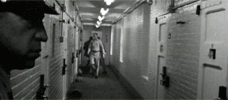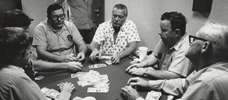Reviews
Frederick Wiseman
USA, 2001 / 2002
Credits
Review by Jenny Jediny
Posted on 27 June 2008
Source Zipporah Films DVD
Categories Frederick Wiseman
Both Domestic Violence and Domestic Violence 2 open with police officers visiting a home where domestic violence has been reported. These scenes are brief, but demonstrate the confusion of the awkward situation—Frederick Wiseman doesn’t capture any of the physical violence on camera but instead deals with the aftermath and the removal of the victim from the scene. The most visually nauseating moment occurs early on, as a woman is removed from her home on a gurney, with blood running profusely down her face, staining her white housedress. While disturbing in themselves, these scenes also abruptly and uncomfortably document the dysfunctional relationships between these couples. Though they are often older adults, there is something disturbingly childlike in their bickering that seems as though it could quickly turn ugly, offering a glimpse of what may have caused the phone call to the police. The oral histories that follow - statements both at the women’s shelter and the courthouse in the second film - echo these moments and provide a very clear idea of what Wiseman’s cameras do not record.
While Wiseman certainly focuses on abused women (abused men are mentioned, but never examined in these documentaries), he often shifts his camera’s attention to the employees assigned to abuse victims, with shelter workers dominating the first film, the Tampa, FL, court system the second. While each victim is in reality an individual, Wiseman’s filming technique imitates the endless stream of victims who move through these buildings and these workers’ lives. At the shelter, counselors admit recent runaways in a long succession, and, more extremely in Domestic Violence 2, the court holds a numbing amount of hearings on domestic abuse cases. (They do, honestly, feel never-ending.) Pushing the notion of the everyday in social work, Wiseman films a discussion on a case concerning sexual abuse not only between a parent and child, but also between young siblings. The matter is handled with urgent efficiency, but also with little reaction; what may horrify the viewer is clearly a difficult, full-day’s work for the shelter employees. In the courtroom, judges can’t hide their exasperation as couples argue and women go back on their accusations, staring blankly as the judge rattles off a history of abuse that they now deny. The delicate nature of mediating these cases is painfully clear; while these adults may be consenting, their inability to determine their own well-being wears thin on both the viewer and authorities, despite the unmistakable necessity of the intervention.
What’s unusual here are the women’s stories, which receive not only more screen-time in Domestic Violence but also a warmer reception by Wiseman’s camera than in the second film. One after another, and yet another, the film draws us in and gives faces to what can feel like a blur of many voices sharing, in many ways, the same painful experience. It’s not a new observation that abuse victims are often addressed as statistic, anonymous cases to be dealt with in a highly bureaucratic system—and yet Wiseman captures both sides of the issue. While Wiseman patiently shows us the workings of that system, he documents individuals at rock bottom, and how - slowly - the system helps these women not only build up their confidence, but also re-establish their lives. Filming within the confines of the women’s shelter in Domestic Violence, Wiseman has access to abuse survivors speaking not only to counselors but also to one another, ensuing in a productive channel of venting where these women can relate and learn from one another. This is given a strong counterpoint in Domestic Violence 2: the courtroom takes us back a step, as the majority of women present have not entered a shelter and in many cases, want to drop charges against the accused. Filmed in a similar style, Domestic Violence 1 and 2 are both daunting in the end, as they come full circle and bring us right back to the beginning of the first film and to the cycle of abuse. It’s sadly evident that the women in court in Domestic Violence 2 who go home with the accused will most likely end up back in court, if not dead.
The core frustration of watching Frederick Wiseman’s Domestic Violence is perhaps summed up best by an early scene in the first volume of the two-part documentary: sitting with a counselor, a woman reveals details of the emotional and physical abuse from her husband, whom she has finally left. We listen to her answers with little surprise, as her individual story is similar to (but no less upsetting than) the confessional moments with other abused women prior to this scene. However, as the woman recounts her history, she casually mentions how her education - specifically, her doctorate - was one of the many aspects of her life that threatened her husband. The casual mention of her impressive degree is jolting and sticks in the mind. Why would anyone stay with a partner who hits, throws, pushes, or verbally assaults? The age gap between the women filmed here (early-twenties to a woman in her eighties) and the time they’ve spent with these men is as sad as it is frightening.
Although they don’t necessarily answer the barrage of questions they propose, Domestic Violence 1 and 2 succeed in capturing the continual relevancy of this issue without becoming preachy or overwrought. Watching the films, I found my frustration often matched that of the shelter employees or judges—it’s easy to grow impatient during Domestic Violence, although it’s just as hard to turn away. This may be one of Wiseman’s most effective documentaries, and is assuredly haunting. Despite the breakthroughs we do witness, the final sequences in the courtroom are unnerving in their reminder that while this is the exasperating daily 9-5 for so many, their actions are perhaps the only reason so many abuse victims survive.
More Frederick Wiseman
-

Titicut Follies
1967 -

High School
1968 -

Law & Order
1969 -

Basic Training
1971 -

Juvenile Court
1972 -

Primate
1974 -

Welfare
1975 -

Meat
1976 -

Sinai Field Mission
1978 -

Manoeuvre
1979 -

Model
1980 -

The Store
1983 -

Blind
USA -

Adjustment & Work
1986 -

Missile
1987 -

Central Park
1989 -

Near Death
1989 -

Aspen
1991 -

Zoo
1993 -

High School II
1994 -

Ballet
1995 -

La Comédie-Française
1996 -

Public Housing
1997 -

Belfast, Maine
1999 -

Domestic Violence / Domestic Violence 2
2001 / 2002 -

The Last Letter
2002 -

State Legislature
2006
We don’t do comments anymore, but you may contact us here or find us on Twitter or Facebook.



